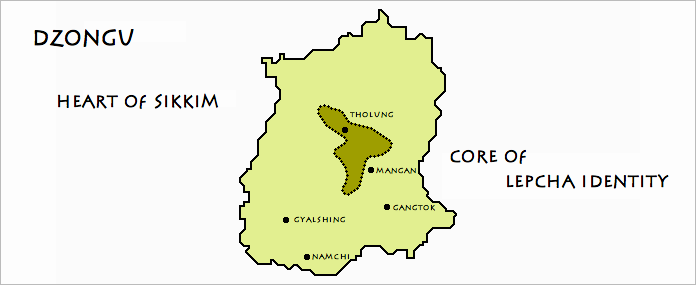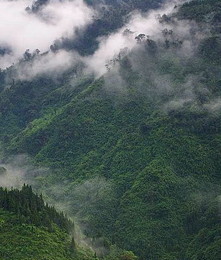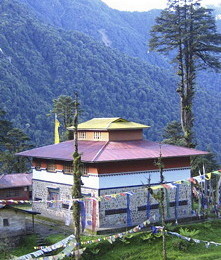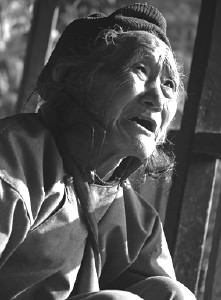
Dzongu
Holy Land of the Lepcha
According to the sacred Neyig, Rigdzin Sogdrub and Lama Gongdue treasure texts (terma), Sikkim as Beyul Demojong (hidden country of sacred treasures) has been mentioned as the land visited by the greatest of Bodhisattavas like the compassionate Avalokiteshvara (Chenrezig) and Tara Devi, followed by celestial King Indra, Chogyal Songtsen Gampo, etc. several thousand years back.
This was followed by the 8th century visit of the Mahaguru Padmasambhava along with a retinue of Khandro Yeshi Chogyal, Chogyal Trisong Detsen and Acharya Santarakshita (Khenchen Bodhisattva). During this visit, the great Mahaguru had hidden several major and minor Dharma treasures (ter) in Sikkim. This includes 118 major treasures, 5 more prosperous treasures, infinite more others, in several designated locations of this Beyul Demojong.
Further, in the sacred Neyig scripture, each and every peak, cliff, river, lake, rock, vegetation of this land has been mentioned as the abodes of different deities numbering about 6000. In fact, this sacred land is compared as equal to the Buddha's Pure Land itself. Guru Rinpoche, as such had appointed Khangchendzonga the supreme protector of all the above mentioned Dharma treasures and sacred locations.
Sikkim's revered Tholung Monastery in Dzongu in North Sikkim houses some of the rarest Dharma treasures including relics and belongings of the Mahaguru Padmasambhava, Khandro Yeshi Chogyal and Gyalwa Lhatsun Chenpo Namkha Jigme. Apart from this, the Monastery also preserved till day a self-appearing image of the Mahaguru.
A little above this world renowned Monastery is the most holy Kagey Lhatso or the Lake Kyishong, one of the abodes of the Mahaguru as mentioned in the sacred Neyig scripture. In fact, a recent photograph of this sacred lake explicitly reveals self-formation of several Bodhisattavas, deities and Sikkim's guardian deity Khangchendzonga.
At the base of the Tholung Monastery in Dzongu are the sacred Zhutol Phug and Wosel Phug which were consecrated by the Mahaguru himself. The Ling-ney-tsu of Dzongu houses some of more such sacred sites as mentioned in the Neyig scripture, e.g. Tso Melong, etc.
The annual Nesol and Pang Lhabsol rituals are important ceremonies performed in the Sikkimese Monasteries to propitiate and honour all the above mentioned sacred sites, deities, etc. alongwith others. These specific prayers are conducted by the monks and bongthings according to their most intricately appointed specifications, established since long.
Hence, in order to contradict all these sacred visions and prophecies, one should either be more intelligent or enlightened or at least equal to the Mahaguru. Keeping in consideration of such immense and sacred visions and prophecies of the Mahaguru and the far-sighted Denjong Chogyals - celestial descendants as mentioned in the Rigdzin Sogdrub scriptures - had passed several laws and enactments giving due recognition and protection to the same. One such important law is the Royal Proclamation of August 30, 1956 that has declared the entire Dzongu area as a special reserve, a law still valid and protected under Article 371F of the Indian Constitution.

Therefore, Dzongu and its Lepcha inhabitants qualify for far-reaching protection against interference from outside. To the Lepcha, this is Faokraam Takraam, their sacred homeland. They have strong ties with the nature and have lived here for centuries. Bordering to the Khangchendzonga Biosphere Reserve (KBR), Dzongu is sparsely populated and covered with dense vegetation. Permission from the government is required to enter Dzongu.
In sheer disrespect for the cultural and religious heritage of the Lepcha as well as for the proclamation of the 11th Chogyal and the Union laws protecting KBR core and buffer zones, the Chamling administration was about to mutilate Dzongu with six hydroelectric power plants. A long and grim campaign of resistance headed by the Affected Citizens of Teesta (ACT) including Sikkim's longest hunger strike was required to avert at least four projects. At present, clearances and land acquisition for Teesta Stage IV and Panan HEP are under way.
SIBLAC has requested the Union authorities to declare Dzongu a National Heritage Area in order to safeguard the Lepcha reserve against intrusion and greed once and for all.
Resources: Vibha Arora - The Forest of Symbols Embodied in the Tholung Sacred Landscape of North Sikkim

Faokraam Takraam

Sacred Tholung Monastery

Ajho Samdup Taso (1928 - 2011)
Venerable Samdup Taso Lepcha was the last in a long and ancient line of Bongthings leading the rituals and prayers to Khanchendzonga, the eternal guardian deity of Beyul Demojong.